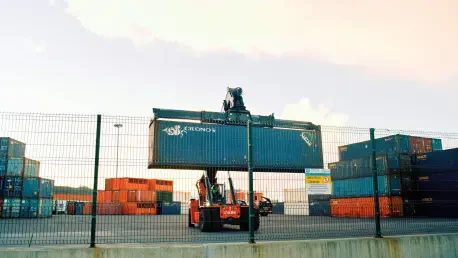With an impressive track record in strategic logistics and digital innovation, Björn Müller has recently been appointed as the Chief Information Officer and Senior Vice President of Business Process Optimization for DHL Global Forwarding in the Asia Pacific region. Bringing his extensive experience from Europe, Müller is poised to drive the next phase of digital transformation and operational excellence in one of the world’s most dynamic freight markets. In this interview, Müller shares insights about his new role, the impact of past achievements, and his vision for the future of DHL in the Asia Pacific landscape.
What motivated you to take on the role of Chief Information Officer and Senior Vice President of Business Process Optimization at DHL Global Forwarding in Asia Pacific?
The opportunity to join the Asia Pacific region is incredibly exciting given its rapid economic growth and increasing trade volumes. My motivation comes from the chance to innovate within a region that’s pivotal to the global freight industry. Moreover, building upon Lawrence Lee’s legacy and contributing to DHL’s continued leadership in logistics were compelling reasons for me to step into this role.
Can you describe your previous experiences at DHL and how they have prepared you for this new role?
Starting as a Senior Consultant focusing on strategic logistics, IT, and finance projects, I’ve had the chance to understand different facets of DHL. Leading the Service Catalogue & Product Excellence and later as Vice President of Digital Customer Interaction deepened my grasp on digital solutions and customer engagement. The blend of strategy and execution in these roles has equipped me to tackle complex challenges in the Asia Pacific region.
What are some of the key achievements during your time as CIO at DHL Freight DACH, UK & Ireland that you are most proud of?
One of the highlights was renegotiating supplier contracts to foster greater efficiency. Additionally, implementing EVO, our single TMS, unified operations across Europe and improved collaboration across business and support functions. These achievements not only optimized processes but paved the way for digital innovation, a legacy I am proud of and carry forward to my new role.
Could you explain the role and impact of the EVO implementation across Europe and how similar initiatives could benefit the Asia Pacific region?
EVO radically streamlined operations by integrating systems and standardizing processes, which led to substantial efficiency gains. In Asia Pacific, a similar initiative could transform operational workflows, reducing redundancies and enhancing customer service. The region’s complex logistics landscape would greatly benefit from such technological unification.
As the former Managing Director of Agheera, how did you achieve consistent year-over-year EBIT growth?
Our strategy at Agheera was rooted in innovation and aligning solutions closely with market needs. By focusing on providing value through advanced telematics, we consistently improved service offerings, enhancing customer satisfaction and profitability. This growth strategy proved effective in adapting to evolving industry demands.
In what ways do you plan to leverage your expertise in digital solutions to drive efficiency in the Asia Pacific freight industry?
Digital solutions are key to unlocking efficiency. I aim to introduce technologies that enhance transparency, speed, and reliability in our processes. This involves not just operational changes but fostering a culture that embraces data-driven decision-making to transcend traditional logistics limitations.
How would you describe the current state of DHL Global Forwarding in Asia Pacific, and what areas do you think need immediate attention or improvement?
Asia Pacific is dynamic with vast potential, yet challenges remain. Immediate focus areas include refining digital processes and enhancing customer experience. As economic activities grow, so does competition, making it crucial to innovate and refine our operations to maintain our leadership position.
What new technologies or innovations do you plan to introduce to enhance operational efficiency and customer experience in this region?
We’re exploring AI-driven analytics, blockchain for transparency, and IoT devices for real-time tracking to revolutionize our logistics operations. By integrating these technologies, we aim to provide more accurate, reliable, and faster services, greatly enhancing the overall customer experience.
How do you envision the impact of digital transformation on the freight industry in Asia Pacific over the next few years?
Digital transformation will redefine how we engage with customers and manage operations. I foresee a shift towards complete transparency, where data-driven insights lead to more informed decision-making. This transformation will make the industry more responsive and adaptable to market changes and customer expectations.
How do you plan to build on the foundation set by Lawrence Lee, and what fresh ideas do you hope to implement?
Lawrence laid a robust infrastructure that I’ll leverage to introduce new technology and innovation. I hope to implement systems that offer predictive analytics and foster a more collaborative and agile work culture. These ideas aim to not only meet current demands but anticipate future needs.
Communicating with a culturally diverse team can be challenging. How do you plan to ensure effective collaboration within the Asia Pacific team?
Effective collaboration hinges on understanding diverse perspectives. My approach involves establishing clear communication channels and encouraging an inclusive environment where every team member feels valued. Through regular engagement and feedback, I hope to bridge cultural gaps and create a cohesive team dynamic.
As you settle into your new role in Singapore, what are your immediate priorities for the coming year?
My immediate priorities include assessing current operations, identifying key areas for digital enhancement, and building strong relationships with the local team. Ensuring a smooth transition and setting a strategic roadmap for the upcoming years will be crucial in my first year here.
Can you discuss the significance of working closely and reporting to both Guido Rietra and Niki Frank in your new role?
Reporting to Guido and Niki offers valuable perspectives from both global and regional standpoints. Their insights will be instrumental in aligning our strategies with larger organizational goals while tailoring them to Asia Pacific’s unique market conditions. This dual guidance ensures that we’re on a path to sustained growth and innovation.
What strategies do you believe are crucial to maintaining DHL Global Forwarding’s position at the forefront of the Asian logistics market?
Maintaining our position involves a relentless focus on innovation, customer-centric solutions, and operational excellence. By continuously integrating cutting-edge technology and refining our offerings, we can meet the ever-evolving needs of our clients and outpace competitors in delivering exceptional services.
What is your forecast for the impact of digital transformation on the freight industry in Asia Pacific?
Digital transformation is set to be a game-changer, fostering a more nimble approach to freight management. I predict significant advancements in speed, reliability, and efficiency, creating a more resilient industry. This transformation will not only streamline supply chains but also offer competitive advantages in an increasingly digitized world.









